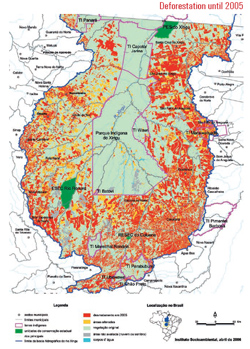Fresh off his huge blockbuster success with Avatar, James Cameron is taking a commendable stand on indigenous issues in the rainforest. Flying down to Brazil’s Amazonian city of Manaus recently, the film director criticized the Belo Monte hydro electric dam project. “For people living along the river, as they have for millennia,” he said, “the dam will end their way of life. I implore the Brazilian government, and President Lula, to reconsider this project.”
To his credit, Cameron did not simply pop up in Manaus impromptu without getting the full inside story behind hydro-power. With the help of hardworking and dedicated organizations such as Amazon Watch, Cameron toured the Xingu River and attended a gathering of over 100 indigenous leaders from dozens of communities. Not to be outdone, he also visited Altamira, a local town which stands to be flooded by the Belo Monte dam.
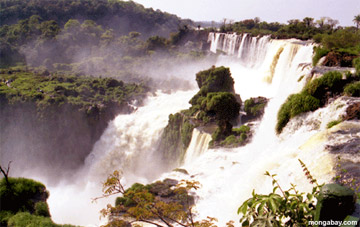 Iguazu Falls on the border of Brazil and Argentina. Photo by Rhett A. Butler. |
Having tackled the thorny problem of environmental destruction in Avatar, Cameron is now adding his own high profile voice to the cause of rainforest preservation. No doubt, the film director has already sensed the disturbing parallels between the virtual, 3-D world of Pandora and the Amazon jungle: just like the fictional Na’vi people, who fight against an earth-based, mining consortium, the Kayapo Indians are fighting to preserve about 500 square miles of their lands threatened by flooding.
Amazonian indigenous peoples, like the Na’vi, maintain intimate connection to the land, rivers and forests. If they are displaced by mega projects such as dams, they lose their culture, history and sense of identity. Belo Monte would be particularly damaging to the environment: if constructed, the project would divert 80 percent of the flow of the Xingu River along a 60 mile stretch, drying up the lifeline of tens of thousands of people who depend on the local water supply.
Despite widespread opposition, the Brazilian authorities recently approved Belo Monte’s environmental license and consortiums will bid on the project in April. Not only is the project an ecological boondoggle but it makes little sense from an energy standpoint. Indeed, Belo Monte would constitute one of the most inefficient dams in Brazilian history.
“There are always other solutions, when good leaders put their will to a problem,” Cameron declared in Manaus. “A WWF [World Wildlife Fund] Brazil study showed if Brazil were to invest a fraction of the cost of the dam in energy efficiency it could generate 14 times the energy of the Belo Monte Dam and have electricity savings of up to US$19 billion,” the director added.
I hope that Cameron will take his activism to the next level and shoot a film about the Amazon, situating hydro power within the larger environmental context. As I reveal in my book No Rain in the Amazon: How South America’s Climate Affects the Entire Planet — now hot off the press from Palgrave-Macmillan — hydro power is just one piece of the overall jigsaw puzzle.
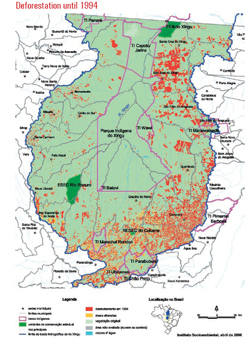 Xingu watershed in 1994
|
In Brazil a nefarious web of soy planters, cattle ranchers and hydropower interests shunt indigenous peoples and others aside while fostering deforestation in the rainforest.
In years past, many in the Global North viewed the Amazon dilemma as an important, but somewhat abstract, environmental issue. That attitude must change: deforestation threatens to unleash a massive carbon bomb while hydropower will lead to dangerous methane emissions, thus exacerbating our climate change conundrum.
Despite the gravity of the situation, some may conclude that the Amazon is a largely Brazilian or Peruvian problem which northerners have little to do with. Think again: it is Europe, the United States, and even China which now consume many of the tropical commodities from the Amazon. Meanwhile, American companies are cashing in on the agribusiness boom in Brazil while large financial institutions backed by the U.S. fund backward environmental enterprises.
Now is the time for Hollywood to take up the vital issue of the rainforest, and Cameron is the ideal director to undertake the project. While a number of Hollywood movies have dealt with the Amazon over the years, none of them have been runaway box office smashes. Given his environmental activism, I think it likely Cameron has at least considered doing a film about the rainforest but publicly there’s been no mention of such a move.
If Cameron were to launch a movie about the tropics, what previous work might he build upon? Hopefully, Hollywood will not seek to rely on the same tired and clichéd plot lines. The analog to Cameron’s Jake Sully, a white man who goes native on Pandora, is Mendoza, a debased slave trader who becomes a Jesuit priest in the 1986 film The Mission. The movie is set in the mid eighteenth century in what is today northeastern Argentina and western Paraguay as Mendoza, played by a horribly miscast Robert De Niro, fights to defend the Indians living in missions from nefarious Portuguese imperial interests.
Writing in the New York Times, Vincent Canby lauded the film for its stunning natural beauty: “the film’s most riveting sequence,” he remarked, “comes at the very beginning, when we see a crucified Jesuit missionary being tossed – cross and all – into the river and carried over the spectacular Iguassu Falls.” On the other hand, Canby was critical of the film in other respects. “The Indians,” he declared, “about whom the film seems to care so much, are condescended to as mostly smiling, trusting, undifferentiated aspects of Eden – innocents with sweet singing voices and a lot of rhythm.”
Other filmmakers such as Werner Herzog have eschewed Hollywood sentimentalism in favor of a more mannered and quirky style. Herzog’s early films dealing with the Amazon, Aguirre, Wrath of God, about a sixteenth century conquistador on the search for the legendary city of El Dorado, and the later Fitzcarraldo, concerning an opera loving madman determined to drag a boat overland from one river to another, were too eccentric to appeal to a mass audience.
On the other hand, White Diamond, Herzog’s recent documentary, is not as overwrought as his earlier movies. It’s about an English aeronautical engineer who designs a balloon which he pilots over the Guyanese rainforest. The film includes breathtakingly beautiful images of the jungle and a dazzling waterfall. Unlike The Mission, White Diamond is not driven so much by narrative than ideas and impressions. The film features occasional voice over by the director.
Trying to get people to the theater to take in a serious and political environmental documentary is a difficult sell, but with the model of White Diamond in hand an enterprising filmmaker could pack in the crowds. Imagine flying over the Andes and down into the jungle, all the while taking in the jungle canopy as in White Diamond. Now imagine taking the same trip, but with 3-D technology as in Avatar.
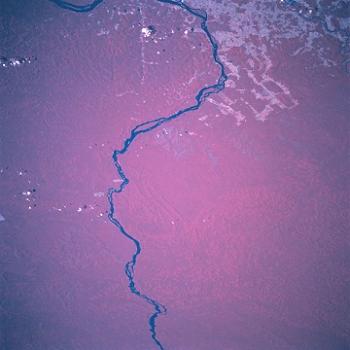 The Xingu River from space. Photo courtesy of NASA. |
A 1983 film, Koyaanisqatsi: Life Out of Balance, about man’s mastery over the earth, was visually stunning. Since then, however, 3-D has taken movie-going to a whole other level.
Ten years ago for example I saw a film about the Galapagos featuring marine iguanas at an Imax theater. Today, we have high definition and National Geographic TV has exploded, so much so that the network now plans to launch an additional network called Nat Geo Wild.
The problem for Americans is that they are cut off from the rainforest, which is abstract and far away. The vast majority isn’t adventurous and will never go to Peru or Brazil to stay in an eco-friendly jungle lodge. That doesn’t mean, however, that northerners aren’t interested in the Amazon. I think if given the chance, they would want to swim with a manatee, even if it were just in the virtual world.
One of the most outlandish creatures on the planet, the shy and retiring manatee is my favorite Amazonian animal. First described as a cross between a seal and hippo, the manatee has a wonderfully round body, mostly black skin the texture of vinyl, a bright pink belly, a diamond-shaped tail, a cleft lip, and a unique sixth sense.
Living life in the slow lane, manatees are fond of doing nothing much at all. However, the manatee does eat a lot of aquatic vegetation. An exclusive vegetarian that feeds on water lettuce and hyacinth, the animal eats 10 percent of its body weight in a single day. Not surprisingly manatees are robust—they can grow up to ten feet long and weigh nearly a ton.
As a recent documentary about the Ecuadoran Amazon entitled Crude demonstrated, you can be political about environmental issues and make your point without hitting people over the head. Crude, shot in cinema vérité style, was compelling without resorting to incessant narration [to read my movie review of the film, see my blog here].
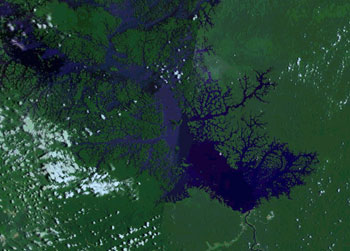 Balbina dam outside Manaus, Brazil. The Balbina dam flooded some 2,400 square kilometers (920 square miles) of rainforest when it was completed. |
Crude, however, did not concentrate very much on wildlife and it is here where future filmmakers could make their mark. Those who do undertake the arduous trek to the rainforest may have dreamt all their lives about seeing certain animals. For me, the primary objective was to see a manatee and in Iquitos I finally got my chance.
At an installation belonging to the Institute of Peruvian Amazon Research outside of town, I saw a couple of caretakers throwing lettuce into open-air tanks. In the first tank, a pint-sized baby dolphin was scratching its back against a wood pole. Walking further, I spotted another tank full of juvenile manatees, and, in a third, a baby manatee all on its own.
By the look of it, the infant was not doing too well. One of the staff explained that the caretakers found the animal in a severely malnourished state. While seeing the manatees was certainly one of the highlights of my trip, it was disappointing to observe the infant in such a poor state of health.
In 2005 observers were saddened by the sight of dying manatees lying in local rivers. According to the Brazilian environmental agency, more than one hundred of the rare aquatic mammals could have died as a result of a drought thought to be linked to warming currents in the Atlantic.
In addition to climate change, the manatee faces a number of other daunting threats including rainforest destruction, dam building, and accidental drowning in commercial fishing nets. If that were not serious enough, the manatee is hunted for its meat and oil, which has taken a toll. It’s impossible to say how many manatees are left, perhaps fewer than 10,000 in the Amazon region.
Americans want to see all the wonders of the Amazon and to feel connected to exotic wildlife. New cinematic technologies now make that possible. However, the audience needs to be brought inside the corporate board rooms and high up government offices where lasting decisions are made about the rainforest’s future and the plight of the manatee. A cinema vérité film, particularly if it is pushed by a high profile director, could raise consciousness in the Global North without necessarily being overly didactic or preachy.
Nikolas Kozloff is the author of No Rain in the Amazon: How South America’s Climate Affects the Entire Planet (Palgrave-Macmillan, April 2010). Visit his web site, http://www.nikolaskozloff.com/
(04/01/2010) After creating a hugely successful science-fiction film about a mega-corporation destroying the indigenous culture of another planet, James Cameron has become a surprisingly noteworthy voice on environmental issues, especially those dealing with the very non-fantastical situation of indigenous cultures fighting exploitation. This week Cameron traveled to Brazil for a three-day visit to the Big Bend (Volta Grande) region of the Xingu River to see the people and rainforests that would be affected by the construction of the Belo Monte Hydroelectric Dam. Long-condemned by environmentalists and indigenous-rights groups, the dam would destroy 500 square kilometers of pristine rainforest and force the relocation of some 12,000 people.
Environmentalists and indigenous groups decry approval of massive dam in Amazon
(02/02/2010) The approval of the hydro-electric Belo Monte Dam from the Brazilian environmental agency, IBAMA, has raised condemnations from environmentalists and indigenous groups. The dam will divert the flow of the Xingu River, a tributary of the Amazon River, which runs through the Amazon in northeast Brazil. According to critics the dam will destroy vast areas of pristine rainforest, disrupt sensitive ecosystems, and relocate 12,000 people.
Blackout in Brazil: Hydropower and Our Climate Conundrum
(11/19/2009) It’s everyone’s worst nightmare: being caught in an underground subway in the midst of a power outage. Yet, that is exactly what happened recently when Brazilian commuters in the city of São Paulo were trapped inside trains and literally had to be pulled out of subway cars. In addition to sparking problems in public transport, the blackout or apagão led to hospital emergencies and the shutting down of several airports. In all the power outage darkened approximately half of the South American nation, affecting sixty million people.
Judge suspends Amazon dam project due to legal questions
(04/30/2008) A Brazilian judge has issued a restraining order on a controversial dam in the Amazon basin, reports International Rivers, a conservation group.
How to end Madagascar’s logging crisis

(02/10/2010) In the aftermath of a military coup last March, Madagascar’s rainforests have been pillaged for precious hardwoods, including rosewood and ebonies. Tens of thousands of hectares have been affected, including some of the island’s most biologically-diverse national parks: Marojejy, Masoala, and Makira. Illegal logging has also spurred the rise of a commercial bushmeat trade. Hunters are now slaughtering rare and gentle lemurs for restaurants.
Satellites being used to track illegal logging, rosewood trafficking in Madagascar

(01/28/2010) Analysts in Europe and the United States are using high resolution satellite imagery to identify and track shipments of timber illegally logged from rainforest parks in Madagascar. The images could be used to help prosecute traders involved in trafficking and put pressure on companies using rosewood from Madagascar.
Coup leaders sell out Madagascar’s forests, people
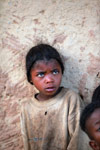
(01/27/2010) Madagascar is renowned for its biological richness. Located off the eastern coast of southern Africa and slightly larger than California, the island has an eclectic collection of plants and animals, more than 80 percent of which are found nowhere else in the world. But Madagascar’s biological bounty has been under siege for nearly a year in the aftermath of a political crisis which saw its president chased into exile at gunpoint; a collapse in its civil service, including its park management system; and evaporation of donor funds which provide half the government’s annual budget. In the absence of governance, organized gangs ransacked the island’s biological treasures, including precious hardwoods and endangered lemurs from protected rainforests, and frightened away tourists, who provide a critical economic incentive for conservation. Now, as the coup leaders take an increasingly active role in the plunder as a means to finance an upcoming election they hope will legitimize their power grab, the question becomes whether Madagascar’s once highly regarded conservation system can be restored and maintained.
